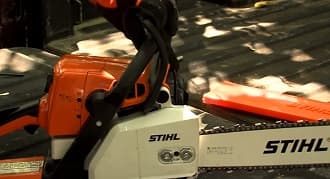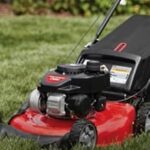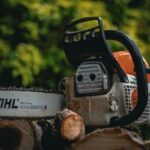As an Amazon Associate, this site earns commissions from qualifying purchases. For more information click here.
A chainsaw that does not start is a well-known problem, but sometimes the opposite happens and the engine revs too much. Too much revving can cause the engine to overheat and damage its components. With this post you will learn why this happens, how to fix it and how to avoid it, without going to a mechanic.
A clogged air filter can cause a chainsaw to rev without a throttle. It could also be due to an air leak or a very lean fuel mixture. Clean or replace the air filter and use the carburetor adjustment screws to change the fuel mix ratio.
How to Fix a Chainsaw That Revs without Throttle
If your chainsaw is revving too much, do not worry. There is a step by step solution which we will provide here. No need to go to a repair center as you can do this yourself. While there are many chainsaw manufacturers, the repair process is similar.
Requirements
- Chainsaw owner’s manual
- Tachometer (One of the top options is Protomex Digital)
- Screwdriver
- Wrench
- Gloves
- Safety goggles (the Dewalt Safety Goggles is ideal for this)
- Soapy water
- Wire brush
Step 1: Clean or Replace the Air Filter
Chainsaw air filters accumulate dirt and get clogged up. To clean or replace the filter, remove the filter cover. Usually it is on either side of the chainsaw. In some chainsaws you have to remove screws, and in others just lift some latches.
Either way, remove the filter from its housing. If the filter is damaged replace it. If the filter is dirty put it in a container of soapy water. You can also wipe the filter dirt off with a brush. Let the filter dry before putting it back on.
You might want to try the chainsaw now to see if it is fixed. But since you have started, might as well check the other parts and determine which needs to be cleaned or replaced.
Step 2: Clean the Spark Arrestor and Muffler
Consult your owner’s manual to find the muffler. Remove the screws or bolts holding it in place. Clean or replace it, whichever is required. Do the same for the spark arrestor. In both cases a brush will be enough to get rid of the dirt.
At this point you can turn to the carburetor adjustment screws. But if there are other issues with your chainsaw, you might want to inspect the other parts like the spark plug and primer bulb.
Step 3: Check the Carburetor Adjustment Screws
The carburetor controls the speed and fuel mix in your chainsaw. There are three adjustment screws:
Idle screw: determines how much air and fuel gets in the engine. Set it to high and the RPM will go up. Set it to low and fuel flow is limited. This has a direct effect on how the engine runs.
L screw: this controls how much fuel gets to the carburetor when the chainsaw is idling. If you loosen this screw, the fuel mixture becomes rich (more fuel, less air). If you tighten the screw, the fuel gets lean (more air, less fuel). If the fuel is too lean, the engine can over rev. If it is too high the RPMs go down.
H screw: the H screw controls how much fuel goes into the carburetor when the throttle is engaged. The tighter this screw, the less fuel gets in the carburetor. This causes the chainsaw to run lean. When you loosen the screw, more fuel flows and the fuel gets richer.
Take note of the original position of the screws. Now it is time to make some adjustments.
Step 4 Adjust the Carburetor Screws
Turn your chainsaw on and let it idle for a minute or so. If it revs without a throttle, odds are the fuel mix is too lean.
Use a screwdriver to adjust the L screw. In this case you want to make the fuel mix richer, so loosen the L screw. If the chainsaw halts while idling, tighten the L screw a little. Make adjustments in increments and note the changes.
Observe the chain. If it remains still while the chainsaw is idling, do not adjust the idle screw. If the chain is moving, the idle screw has to be loosened a little. Keep adjusting incrementally until the chain stops.
If the engine is still over revving you have to adjust the H screw. Check your owner’s manual for the ideal RPM, or you can use a tachometer.
Increase the RPM as the chainsaw runs. Tighten the H screw to the maximum position. Turn the screw halfway and loosen it. The goal is to run the chainsaw at 2000 RPM lower than its maximum capacity. Keep turning the H screw until that level is reached.
How to Prevent Chainsaws from Over Revving
If you chainsaw keeps revving without engaging the throttle, use a richer fuel mix. You should also check for an air leak in the carburetor. The leak can also come from the fuel reservoir. Either way it will cause the chainsaw to rev at a high rate.
Gas chainsaws can run with different air to fuel mix levels, but this affects performance. If the fuel is too rich the chainsaw can smoke. If it is too lean the engine can rev too much.
An air leak adds air to the fuel mix and turns it lean. If it is too lean the RPMs increase and so does the engine revs. The higher and longer the revs, the higher the temperature gets. This will cause the engine to overheat.
Air leaks can happen due to wear and tear and other reasons. But this is only one possibility. A dirty air filter can also cause the RPM to increase.
What happens if you let the chainsaw rev like this? It will eventually wear out the engine and damage it. As indicated earlier, it is easy to clean and replace the air filter. Make this a part of your regular chainsaw maintenance and it will save your engine.

Why Do Chainsaws Rev High and Cut Out?
Air inlet tear. There is probably an issue with the air intake. Check the section between the engine and the carburetor and you will see a rubber-like material. It is the inlet manifold. This part gets hard or suffers a tear. If this happens the engine will rev up and die out. Check the manufacturer’s website if you can get a replacement for it.
Carburetor needs adjustment or cleaning. This revving problem can also be fixed by adjusting the carburetor screws. Adjust the screws and observe the effect. This situation can also arise from a lack of fuel or the wrong fuel mix.
If adjusting the carburetor screws does not work, the carburetor itself might need cleaning. Just like the rest of the engine, carburetors build up dirt over time but all you need is a carburetor cleaner and that should be enough.
Dirty fuel filter. Most revving and throttling issues are caused by a clogged air filter. But sometimes a dirty fuel filter can cause the same type of problem.
The fuel filter screens out dirt and debris, ensuring clean fuel and air gets in the system. But through heavy use, the filter gets dirty. When that happens not enough air reaches the carburetor, causing the fuel to run lean. As explained earlier, if the fuel is too lean the engine will rev too much.
What you have to do is unplug the fuel filter from the fuel line. In most instances it is easier to buy a new fuel filter than clean the current one. But it depends on the chainsaw and if its fuel filter is reusable.
Broken fuel line. A damaged fuel line is another potential air leak source. If the fuel line is broken, not enough fuel will get into the engine. This imbalance will make the mixture lean and produce the excessive revving you are trying to avoid. Replacing the fuel line is a must in these situations.

I love the outdoors and all the tools for maintaining gardens, yards and lawns. The only thing I am more passionate about is sharing what I know about garden and outdoor equipment.


